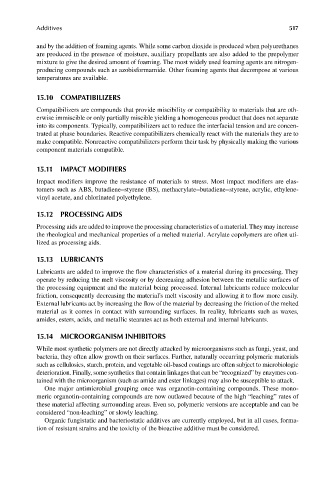Page 554 - Carrahers_Polymer_Chemistry,_Eighth_Edition
P. 554
Additives 517
and by the addition of foaming agents. While some carbon dioxide is produced when polyurethanes
are produced in the presence of moisture, auxiliary propellants are also added to the prepolymer
mixture to give the desired amount of foaming. The most widely used foaming agents are nitrogen-
producing compounds such as azobisformamide. Other foaming agents that decompose at various
temperatures are available.
15.10 COMPATIBILIZERS
Compatibilizers are compounds that provide miscibility or compatibility to materials that are oth-
erwise immiscible or only partially miscible yielding a homogeneous product that does not separate
into its components. Typically, compatibilizers act to reduce the interfacial tension and are concen-
trated at phase boundaries. Reactive compatibilizers chemically react with the materials they are to
make compatible. Nonreactive compatibilizers perform their task by physically making the various
component materials compatible.
15.11 IMPACT MODIFIERS
Impact modifiers improve the resistance of materials to stress. Most impact modifiers are elas-
tomers such as ABS, butadiene–styrene (BS), methacrylate–butadiene–styrene, acrylic, ethylene-
vinyl acetate, and chlorinated polyethylene.
15.12 PROCESSING AIDS
Processing aids are added to improve the processing characteristics of a material. They may increase
the rheological and mechanical properties of a melted material. Acrylate copolymers are often uti-
lized as processing aids.
15.13 LUBRICANTS
Lubricants are added to improve the flow characteristics of a material during its processing. They
operate by reducing the melt viscosity or by decreasing adhesion between the metallic surfaces of
the processing equipment and the material being processed. Internal lubricants reduce molecular
friction, consequently decreasing the material’s melt viscosity and allowing it to flow more easily.
External lubricants act by increasing the flow of the material by decreasing the friction of the melted
material as it comes in contact with surrounding surfaces. In reality, lubricants such as waxes,
amides, esters, acids, and metallic stearates act as both external and internal lubricants.
15.14 MICROORGANISM INHIBITORS
While most synthetic polymers are not directly attacked by microorganisms such as fungi, yeast, and
bacteria, they often allow growth on their surfaces. Further, naturally occurring polymeric materials
such as cellulosics, starch, protein, and vegetable oil-based coatings are often subject to microbiologic
deterioration. Finally, some synthetics that contain linkages that can be “recognized” by enzymes con-
tained with the microorganism (such as amide and ester linkages) may also be susceptible to attack.
One major antimicrobial grouping once was organotin-containing compounds. These mono-
meric organotin-containing compounds are now outlawed because of the high “leaching” rates of
these material affecting surrounding areas. Even so, polymeric versions are acceptable and can be
considered “non-leaching” or slowly leaching.
Organic fungistatic and bacteriostatic additives are currently employed, but in all cases, forma-
tion of resistant strains and the toxicity of the bioactive additive must be considered.
9/14/2010 3:42:50 PM
K10478.indb 517 9/14/2010 3:42:50 PM
K10478.indb 517

